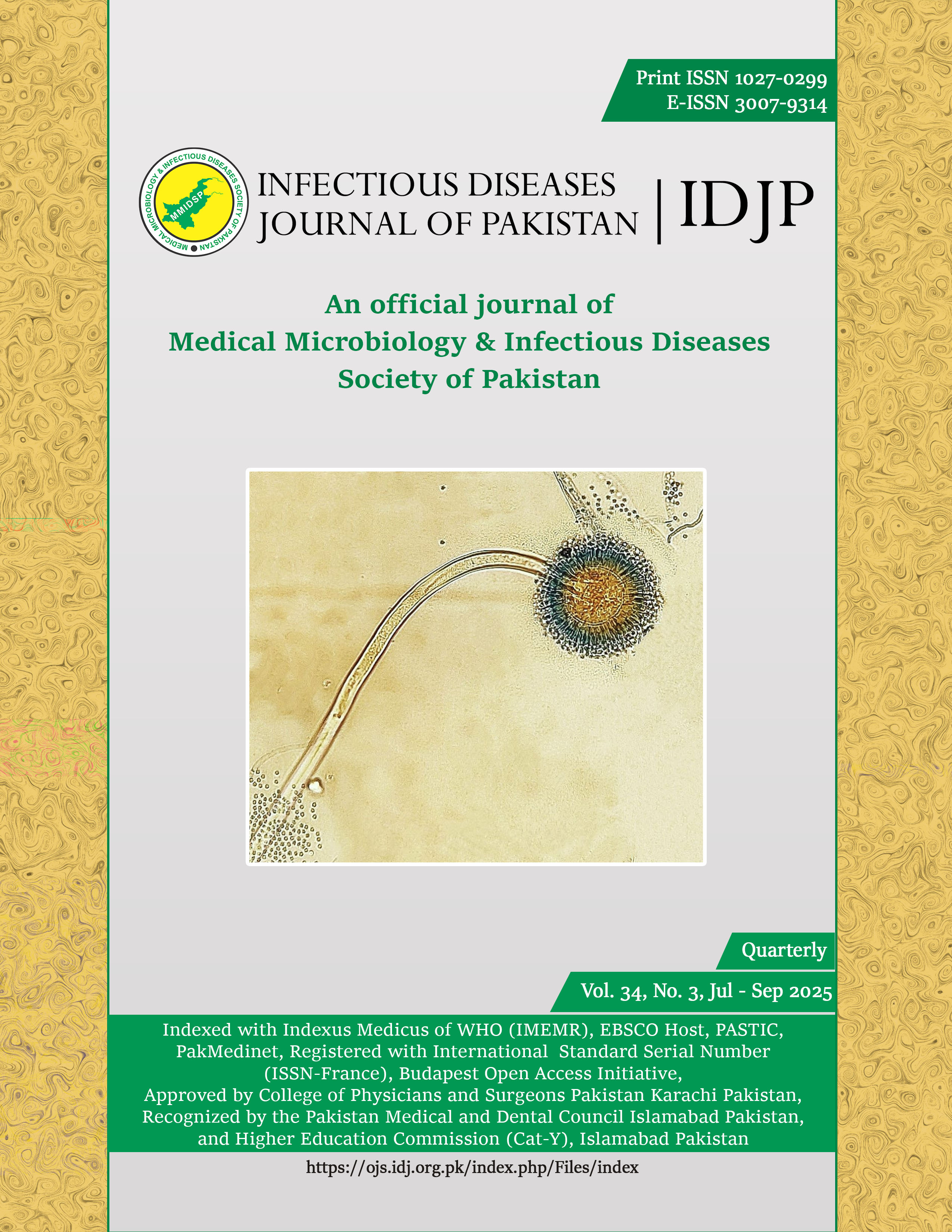Frequency of allergic asthma among diagnosed cases of bronchial asthma presenting in Gulab Devi Chest Hospital Lahore
DOI:
https://doi.org/10.61529/idjp.v34i3.444Abstract
Background: Bronchial asthma is a heterogeneous chronic respiratory condition characterized by airway inflammation and variable airflow limitation. Among its various phenotypes, allergic asthma is the most common, particularly in younger individuals and those with a history of atopy. This study aim was to determine the frequency of allergic asthma among the bronchial asthmatic patients.
Material and Methods: This cross-sectional study was conducted at the Department of Pulmonology, Gulab Devi Chest Hospital, Lahore, from April 28 to July 27, 2025. A total of 379 patients aged 12–75 years were enrolled through non-probability consecutive sampling. Serum IgE levels were determined using ELISA. Chi-square test assessed associations, while independent sample t-test compared mean age between allergic and non-allergic asthma patients.
Results: Among the 379 asthma patients, 219 (57.8%) were identified as having allergic asthma. The condition was more prevalent in females (61.5%) than males (53.2%), though the difference was not statistically significant (p = 0.321). Allergic asthma was most common in the 12–30-year age group (66.7%, p = 0.027). Elevated serum IgE (>200 IU/mL) is significantly associated with allergic asthma (p < 0.001).
Conclusion: Allergic asthma constitutes a major phenotype among bronchial asthma patients, particularly in younger individuals and those with elevated IgE and allergen exposure. Incorporating basic immunologic testing and environmental history into routine asthma assessment can facilitate early identification and enable more targeted, effective management strategies.
Keywords: Bronchial asthma, Allergic asthma, IgE levels, Allergen exposure.
References
Zedan MM, Wassefy ME, Khashaba EO, Sallam H, Mabood SA. Prevalence of bronchial asthma and correlation between the chemokine receptor 3 gene polymorphism and clinical asthma phenotypes among Egyptian asthmatic children. Egyptian Pediatric Association Gazette. 2023; 71(1): 47. DOI: https://doi.org/10.1186/s43054-023-00182-x
Mao Z, Zhu X, Zheng P, Wang L, Zhang F, Chen L, et al. Global, regional, and national burden of asthma from 1990 to 2021: A systematic analysis of the global burden of disease study 2021. Chin Med J Pulm Crit Care Med. 2025;3(01):50-9. DOI: https://doi.org/10.1136/bmjresp-2025-003144
Asseri AA. Characteristics of allergic, eosinophilic, and overlapping asthma phenotypes among pediatric patients with current asthma: A Cross-sectional study from Saudi Arabia. J Asthma Allergy. 2023: 1297-308. DOI: https://doi.org/10.2147/JAA.S439089
Channar N, Dayo A, Ghoto MA, Shah SM, Zaman K. Evaluation of asthma: aggravating factors and family history-a pro-spective observational study. Liaquat Med Res J. 2023; 5(2): 67-73. DOI: https://doi.org/10.38106/LMRJ.2023.5.2-06
Chen M, Shepard K, Yang M, Raut P, Pazwash H, Holweg CT, et al. Overlap of allergic, eosinophilic and type 2 inflammatory subtypes in moderate‐to‐severe asthma. Clin Exp Allergy. 2021; 51(4): 546-55. DOI: https://doi.org/10.1111/cea.13790
Wenzel SE. Severe adult asthmas: integrating clinical features, biology, and therapeutics to improve outcomes. Am J Respir Crit Care Med. 2021; 203(7): 809-21. https://doi.org/10.1164/rccm.202009-3631CI
Schiffers C, Wouters EF, Breyer-Kohansal R, Buhl R, Pohl W, Irvin CG, et al. Asthma prevalence and phenotyping in the general population: the LEAD (Lung, hEart, sociAl, boDy) study. J Asthma Allergy. 2023:367-82. DOI: https://doi.org/10.2147/JAA.S402326
Ogulur I, Mitamura Y, Yazici D, Pat Y, Ardicli S, Li M, et al. Type 2 immunity in allergic diseases. Cell Mol Immunol. 2025:1-32. https://doi.org/10.1038/s41423-025-01261-2
Armeftis C, Gratziou C, Siafakas N, Katsaounou P, Pana ZD, Bakakos P. An update on asthma diagnosis. J Asthma. 2023; 60(12): 2104-10. DOI: https://doi.org/10.1080/02770903.2023.2228911
Baumann R, Untersmayr E, Zissler UM, Eyerich S, Adcock IM, Brockow K, et al. Noninvasive and minimally invasive techniques for the diagnosis and management of allergic diseases. Allergy. 2021; 76(4): 1010-23. DOI: https://doi.org/10.1111/all.14645
Khan SW, Hamid A, Siddiqi FA, Bakhtawar M. Frequency of allergic asthma and common aeroallergens sensitization in Pakistani patients of bronchial asthma. J Pak Med Assoc. 2018; 68(8): 1217-21. Available from: https://www.archive.jpma.org.pk/PdfDownload/8814
Khan MA. Monthly and seasonal prevalence of asthma and chronic obstructive pulmonary disease in the District Dera Ismail Khan, Khyber Pakhtunkhwa, Pakistan. Egypt J Bronchol. 2022; 16(1): 63.
DOI: https://doi.org/10.1186/s43168-022-00166-2
Pakkasela J, Ilmarinen P, Honkamäki J, Tuomisto LE, Andersén H, Piirilä P, et al. Age-specific incidence of allergic and non-allergic asthma. BMC Pulm Med. 2020; 20(1): 9. DOI: https://doi.org/10.1186/s12890-019-1040-2
Zedan MM, Darwish A, Khashaba EO, Osman E, Osman A, Ellithy N. Association between the chemokine receptor 3 gene polymorphism and clinical asthma phenotypes among Egyptian asthmatic children. Alex J Pediatr. 2021; 34(3): 237-42. DOI: https://doi.org/10.4103/1687-9945.337835
Lawson JA, Chu LM, Rennie DC, Hagel L, Karunanayake CP, Pahwa P, et al. Prevalence, risk factors, and clinical outcomes of atopic and nonatopic asthma among rural children. Ann Allergy Asthma Immuno. 2017; 118(3): 304-10. DOI: https://doi.org/10.1016/j.anai.2016.11.024
Chatkin J, Correa L, Santos U. External environmental pollution as a risk factor for asthma. Clin Rev Allergy Immunol. 2022; 62(1): 72-89. DOI: https://doi.org/10.1007/s12016-020-08830-5
Samoo UG, Ehsan S. Prevalence of asthma and allergic disorders in school children of Karachi. Int J Contemp Pediatr. 2021. DOI: https://doi.org/10.18203/2349-3291.ijcp20214071
Aziz DA, Bajwa RA, Omar M, Viquar W. Immunoglobulin IgE levels and clinical dynamics of asthma in children and adolescents. J Ayub Med Coll Abbottabad. 2023;35(4 (Suppl 1): 752-6. DOI: https://doi.org/10.55519/JAMC-S4-12394
Soong W, Yoo B, Pazwash H, Holweg CT, Casale TB. Omalizumab response in patients with asthma by number and type of allergen. Ann Allergy Asthma Immunol. 2021; 127(2): 223-31. DOI: https://doi.org/10.1016/j.anai.2021.04.002
Gon Y, Maruoka S, Mizumura K. Omalizumab and IgE in the control of severe allergic asthma. Front Pharmacol. 2022; 13: 839011. DOI: https://doi.org/10.3389/fphar.2022.839011
Downloads
Published
How to Cite
Issue
Section
License
Copyright (c) 2025 Jamshaid Ahmad, Zaheer Akhtar, Fatima Saeed, Muhammad Bilal Liaqat, Nafees Ahmad, Hafiz Muhmmad Umair

This work is licensed under a Creative Commons Attribution-NonCommercial 4.0 International License.



